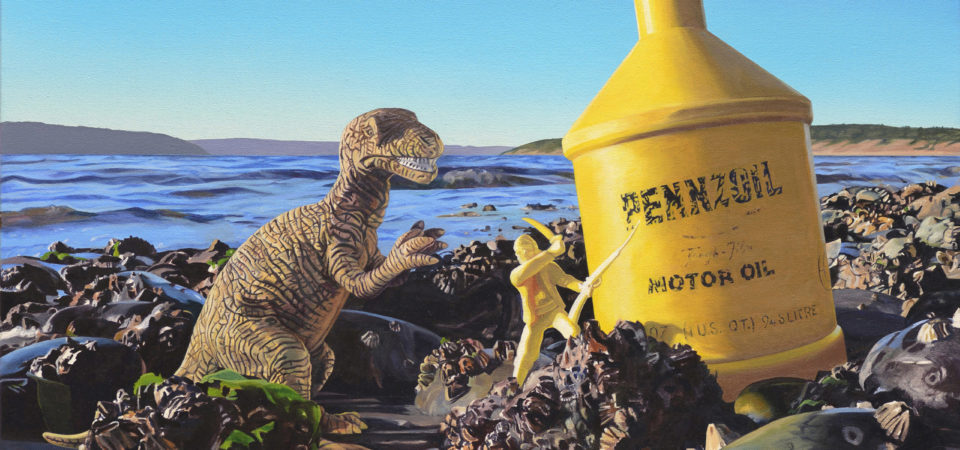The Beasts by Walt Whitman (1855)
I think I could turn and live with animals, they are so placid and self-contain’d,
I stand and look at them long and long.
They do not sweat and whine about their condition,
They do not lie awake in the dark and weep for their sins,
They do not make me sick discussing their duty to God,
Not one is dissatisfied, not one is demented with the mania of owning things,
Not one kneels to another, nor to his kind that lived thousands of years ago,
Not one is respectable or unhappy over the whole earth.
We humans can be an arrogant lot.
Against all logic, we remain unmotivated to change our behaviors and prefer to take the path of least resistance. That we can care so little about our loved ones – flora and fauna including humans – is shockingly evident in our unwillingness to examine our arrogant attitude of false authority over all living things. What does it take for us to stop a moment, to admit we’re wrong, and acknowledge the destructive effect of our addictive consumer habits on our fellow creatures and our species?
Conventional wisdom holds that motivation is the key to habit change. Maybe if you really wanted it, you’d actually do it. But the truth is, our real motivation is to be lazy and to do what is convenient. And despite what the latest best-seller will tell you, this is a smart strategy, not a dumb one. Energy is precious, and the brain is wired to conserve it whenever possible. It is human nature to follow the Law of Least Effort, which states that when deciding between two similar options, people will naturally gravitate towards the option that requires the least amount of work…The more energy required, the less likely it is to occur. ~ Author and habit coach, James Clear
[The] internal sense of rightness that we all experience so often is not a reliable guide to what is actually going on in the external world. And when we act like it is, and we stop entertaining the possibility that we could be wrong, well that’s when we end up doing things like dumping 200 million gallons of oil into the Gulf of Mexico or torpedoing the global economy…few of us change the course of history when we make excuses for being wrong. ~ Author of Being Wrong, Kathryn Schultz
So how do human laziness, and the reluctance to be wrong, affect our level of respect for our fellow creatures? What magnitude of environmental cataclysm will have to take place to finally shove us beyond our lives of convenience, cause us to improve and better protect our relationships with animals, and to eschew selfish immediate gratification and embrace inconvenience in the service of the greater good of us all?
I humbly believe we are not above the beasts, and that we have an ethical and practical responsibility to live among them with due respect. Instead, many of us still justify our subjugation of animals by clinging to obsolete ideas that were born in the stone age and honed through millennia of privileged Judeo-Christian teaching. Since each of the beasts upon the planet has evolved with its own form of native intelligence, suited to a specific region within earth’s ecosystems, I believe that all species have equal value and rights to livelihoods in the habitats within which they’ve emerged.
So, who cares about dumb animals anyway? We’re smarter than them, so we get to rule the world, right?
This could easily be the mantra of the vast majority of humans in western culture. We rail against deer eating “our” flowers, and raccoons eating “our” chickens, or any number of wild animals destroying “our” precious “property”. We are not willing to recognize that along with the privilege of our sentient intelligence comes the obligation to use our clever brains to solve problems, to build better safeguards in protecting the chickens, vegetables, and flowers in our care. If we fail in this charge, it is on our shoulders. When we take the easy way out, by placing the sole blame of lost livestock and crops upon other animal species struggling to feed themselves along-side us, we become less than ourselves.
I am puzzled by the self-righteousness indignance I often hear from folks when I express my fondness for animals. There appears to be a clan of folks among us who delight in knocking down anyone’s feelings of joy for the mutual life force we share with the beasts. When I share animal videos on social media, for instance of a young raccoon’s playful antics in my yard, I usually reap at least one simplistic patronizing comment, like “raccoons are vicious”, and followed by a tirade of vitriol towards them. And then comes the predictable parade of the doomsayers, who carry on about how destructive raccoons and other wild animals are to “their property”.
Huh? What happened to the exquisite pleasure of sharing an innocent moment with a young raccoon?
I’ve noticed that most animals, including and maybe especially humans, are capable of apparently vicious and destructive behavior at times, usually due to fear, protectiveness, or self-preservation. In general, we humans like to think we are very smart, smarter, and therefore superior to the rest of the animal kingdom, and we begrudgingly set aside a small fraction of the earth’s habitat for them. If we are predisposed to take the easiest path, do not value our fellow creatures, and work to see they are provided for, we feel okay about destroying any living thing that gets in our way, and label the less powerful among us as vicious to prop up our entitled self-worth, laziness, and need to be right.
In this way, it becomes convenient for us to label raccoons as vicious, deer as destructive pests, and wolves, coyotes, and bears as livestock killers, and it is how we justify our lack of culpability and deluded sense of superiority. It’s easier to bitch and moan than to face up to wrong thinking; than to think outside the box and use the advantage intelligence to find solutions to live harmoniously with nature. Is there a way we can flip the script, make it easier to access our higher selves, stop whining, and build strong enough chicken coops and fences while maintaining food sources and habitat for wildlife?
Common raccoons who live out in nature can survive for a maximum of 16 years in age. Despite that, the majority of common raccoons don’t make it to 2 years old. ~ Author, Naomi Millburn
So, let’s take a leap and consider a paradigm shift, and ponder how to access compassion and create new models of cohabitation with animals as in the island communities of Bali, Indonesia. In David Abram’s essay, The Ecology of Magic, he gives us a glimpse of an unusual collaborative relationship between humans and the ants that inhabit the island’s forests.
On the second morning, when I saw the array of tiny rice-platters, I asked my hostess what they were for. Patiently, she explained to me that they were offerings for the household spirits…I walked back to my room chuckling to myself. The Balian and his wife had gone to so much trouble to placate the spirits with gifts, only to be stolen by six-legged thieves. What a waste! But then a strange thing dawned on me, what if the ants themselves were the “household spirits” to whom the offerings are made… The family compound, like most of this tropical island, had been constructed in the vicinity of several ant colonies. Since a great deal of cooking took place in the compound… the grounds and buildings were vulnerable to infestations by the ant population… It became apparent that the daily palm-frond offerings served to preclude such an attack by the natural forces that surrounded (and underlay) the family’s land. The daily gift of rice kept the and colonies occupied – and presumably, satisfied. Placed in regularly repeated locations at the corners of various structures around the compound, the offerings seemed to establish certain boundaries between the human and ant communities, by honoring this boundary with gifts, the humans apparently hope to persuade the insects to respect the boundary and not enter the buildings. ~ Author of The Ecology of Magic, David Abram
I firmly believe that the more we care for the happiness of others, the greater our own sense of well-being becomes. ~ His Holiness the Dalai Lama
In addition to our laziness and a distaste for being wrong, consider another obstacle in our paths to right action in ecological preservation – our misunderstanding of what constitutes an actual (unmanipulated) experience as opposed to a mediated (manipulated) experience. In his 1977 book, Four Arguments for the Elimination of Television, Jerry Mander presents the concept of The Replacement Experience and how it keeps us from valuing and protecting natural habitat.
It was reported that in the generation since 1945, 99 percent of the homes in the country had acquired at least one television set…Interpretations and representations of the world were being accepted as experience, and the difference between the two was obscure to most of us…I heard many people say, television is great; there are so many things on TV that we’d never otherwise experience. People were seeing television images of Borneo forests…and they believed themselves to be experiencing these places…Yet the television images of the Borneo forests…[were] surely not the experience of them and not to be relied upon to the same extent. It was the experience of sitting in a darkened room staring at a flickering light, ingesting images which had been edited, cut, rearranged, sped up, slowed down, and confined in hundreds of ways. Were people aware of the difference? Slowly I began to see how the ubiquitousness of television, combined with a general failure to understand what it did to information, might affect the political work we were doing. If people were believing that an image of nature was equal to or even similar to the experience of nature, and were therefore satisfied enough with the image that they did not seek out the real experience, then nature was in a lot bigger trouble than anyone realized. ~ Author of Four Arguments for the Elimination of Television, Jerry Mander
Moving forward in time from 1977 to 2020, we now live within ever-increasing, digitally-mediated environments and have less access to unmediated real experiences. When we live in a world devoid of actual personal interactions with wild animals and wilderness, we cannot know wildness with our senses, and we can mistakenly bring false, fearful, and preconceived notions to our understanding of animals.
Naturalist Charles Bergman, in his essay The Manatee and the Metaphors of Desire, discusses the effect of being seen by a wild animal in its territory in close proximity. A power shift occurs when we humans are not controlling the encounter as the dominating voyeur, but are now the one made vulnerable by being observed.
Usually, with wild animals, I am a spectator, watching them from a distance. With this manatee in the Crystal River, however, I was in her element, swimming with her in a slow-motion process of discovery. I must have been a comical sight: my cheeks squished inside a face mask and my lips almost orange on a cold winter morning. She seemed to like peering at me. Bound in a mutual gaze, we floated together in the water, mask to massive snout…As Freudians and voyeurs know, looking can be an act of power. It is much the same pleasure that an audience has at a play, spectators who see more that can any of the characters on the stage. Being seen, however, reverses the relation, and brings with it a greater sense of vulnerability. We might call this the politics of perception, or the power of the gaze… Perceptual metaphors define a relationship, even if we are unaware that they are doing so. Oddly, it is as if we actually grant existence to other creatures through our eyes…We are reluctant as a culture to protect them until we have seen them, and if we cannot see them, we cannot even prove that they exist – the perfect paradox for an empirical age. How else can we account for the reluctance to set aside chunks of habitat, like national parks in Alaska, for animals most of us may never see? It explains why we remain vulnerable to the old argument that only a few people will get to see these creatures, and what good is that? Until we see them, we somehow fondly believe they don’t exist for us.
~ Author of The Manatee and the Metaphors of Desire, Charles Bergman
As we navigate the current Covid 19 pandemic and are sent outdoors for increased safety, is it possible that this action is having a positive effect on our environmental awareness? Staying at home, and being outdoors while working and playing, provides direct contact with nature and idle time to observe, first-hand, the beasts around us. I’ve heard many say how much they enjoy hearing the neighborhood birds more clearly, because of the reduction of polluting travel that has emptied the roads and skies of noisy cars and planes. Could the pandemic, even with all its drawbacks, be contributing to a deeper friendship with nature, and encouraging a more nuanced ecological understanding and appreciation of animals? Could a greater amount of quiet time spent in the company of animals be a small step towards embracing inconvenience, encouraging us to go out of our way to change our lazy, self-satisfying, consumer habits, and act to protect more of the animal habitat within our orbit?
In the end, we must ask ourselves if we are courageous enough to align ourselves with the beasts of our planet, and decide who we shall inconvenience ourselves to protect.
I, myself, have chosen to embody my beastly power by using a subversively light-hearted approach to the serious subject of ocean degradation in an ongoing series of paintings and drawings – tongue-in-cheek taxonomies of imaginary post-consumer sea creatures. Working traditionally with oil, gouache, and pencil, I lovingly and meticulously craft images of beach trash, aiming for a provocative visual collision of form and idea.
It is possible to find me regularly combing the beaches of Discovery Bay, not looking for shells or natural forms, as I am most interested in the rubbish, but the objects we purposefully ignore and discard. Taking them back to my studio, I monumentalize the collected debris in my large-scale oil paintings. By placing the familiar and disposable in new contexts, I hope to lead my viewers to consider the cost of consumer culture on our environment. Imbued with humor, the work is intended to avoid the didactic tone of many politically engaged artworks. Plastic dinosaurs jostle with toy soldiers, and the unexpected wordplay of the titles encourages delving back into the paintings.
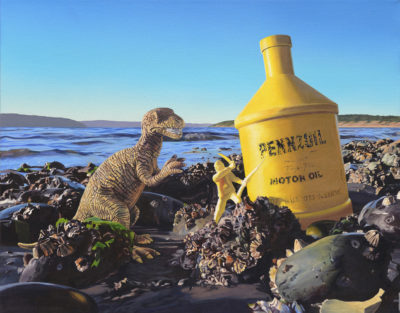
oil on canvas
22 x 28 inches
Collection of Reed & Drinkwine
I’ve found various toy dinosaurs tangled in the seaweed, and they’ve become part of my visual vocabulary. Through free-association, and by linking “fossil fuels” and “dinosaur fossils,” I use the toy dinosaur as a stand-in for more serious concerns about extinctions resulting from obsolete, dinosaur-like ways of thinking and humankind’s collective use of its self-serving reptilian brain. In my painting, Fossil Feud, I pair a dinosaur with a bottle that once contained fossil-based petroleum that is combatively defended by a pirate figurine—an allegory for our current ongoing struggle to embrace a future in clean energy while at the same time battling old guard thinking that clings to obsolete dirty energy paradigms.
I allow my distress with current political affairs to filter down into my subconscious, to bubble up transformed into new unexpected images that reflect our times. As an American living in a country at war with itself, staying grounded and centered is now a more difficult task than ever. Yet my process continues as before, arranging small dramas-on-the-beach with the manmade trash I find there, following my intuition and sense of humor to capture surprising, often poignant, visual narratives that unfold before me. It is through this sort of therapeutic sand-play that I compose the photos that result in my paintings, highlighting the oblivious and destructive foibles of humankind, stories set in the context of our beautiful yet deteriorating natural world.
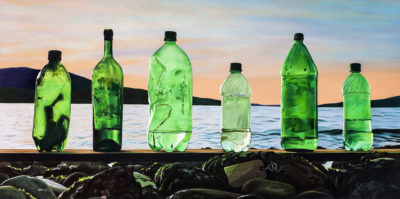
Shades of Green: Amphorae ca. 2012, oil on canvas, depicts six discarded plastic and glass bottles posed on a stranded driftwood board in the evening light. This salty surreal row of discarded green bottles appears to have surfed ashore on ocean waves, escaped intact from a museum exhibit case from the future, and complete with a trompe l’oeil museum tag snagged among the rocks in the foreground. Illustrating the ubiquitous use of the word green as ecological, as well as green as a color, the painting equates common soda bottles with priceless ancient Greek amphorae and provokes questions about the impact and value of 21st-century consumer culture on future generations.
My large-scale oil painting, Have an Ice Day, depicts a tattered plastic party-ice bag sporting the cartoonish graphic of a polar bear floating in limbo over the sea. The party-ice in this bag has long since vanished, just as the ice cubes illustrated on the bag are melting out from under the sunglass-clad ice-bear as he poignantly waves good-bye; a parting metaphor for looming mass extinction in the warming and disappearing habitats of the globe.
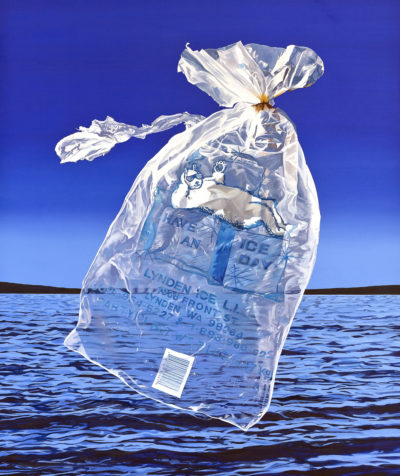
oil on canvas
72 X 60 inches
Collection of Johnna and Fred Kleisner
After my initial Red Tide painting in 2009, I came to see ironic messages about the state of our environment in most every man-made product I found washed up on the beach, which provided me with an endless supply of visual material to make painting after painting on the topic. Oddly this has helped counteract my angst about habitat degradation, enriched me and kept me afloat in these dire times, and engendered hope in me that my ironic humor can encourage others to stay afloat and take action in favor of the beasts.
Note: All quotes cited from other authors have been condensed for brevity.
KAREN HACKENBERG BIO represented by Patricia Rovzar Gallery, Seattle
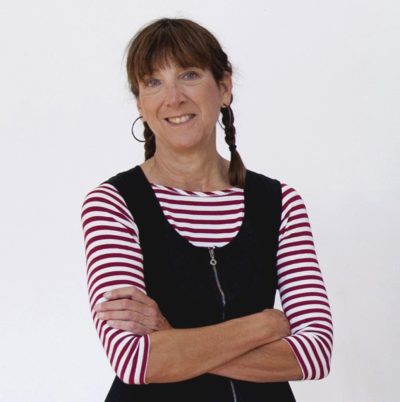 Karen Hackenberg received her BFA in painting from Rhode Island School of Design, moved west to live for a decade and a half in San Francisco, and now lives and works near Seattle, WA.
Karen Hackenberg received her BFA in painting from Rhode Island School of Design, moved west to live for a decade and a half in San Francisco, and now lives and works near Seattle, WA.
Her ongoing painting series are inspired by the incongruity of the man-made detritus that washes up on the otherwise pristine beach below her studio – plastic shards, plastic bottles, plastic toy animals, shotgun shells, and product packages, to name a few. She is influenced by Pop Art of the 1960s – Claes Oldenburg’s monumental everyday objects, as well as Ed Ruscha’s paintings combining marketing graphics with images of nature.
She has recently been awarded an invitation to participate in the 2023 NW Perspectives series at Tacoma Art Museum, in a solo exhibition as a foremost regional artist.
Her work was also chosen for the noteworthy exhibition, Northwest Art Now at the Tacoma Art Museum, curated by TAM’s Rock Hushka, and Juan-Roselione, curator of the Rubell Family Collection, Miami.
Hackenberg’s museum exhibitions also include a solo exhibition at Bainbridge Island Museum of Art; the international traveling show, Environmental Impact II; Neo-Naturalists at Museum of Northwest Art; Stilleven: Contemporary Still Life at Hallie Ford Museum of Art; and Beneath the Surface: Rediscovering a World Worth Conserving at A.A.A.S. headquarters, Washington DC.
Her green sensibility has earned a place in numerous private and public collections, including the New York State Museum, NY, the Portland Art Museum, OR, the Tacoma Art Museum, WA, the Washington State Art Collection, Bainbridge Island Museum of Art, WA, and the Hallie Ford Museum of Art, OR.
Hackenberg’s work is currently featured in notable art magazines, LoDown in Berlin, Germany, and BlackBook in Brooklyn, New York.
A studio interview with Hackenberg, Fine Art from Beach Trash, was recently recorded and aired on King 5 Evening TV, and is now available online.
This blog is part of MAHB’s ENVIRONMENTAL IMPACT II series, a travelling museum’s exhibition.
The MAHB Blog is a venture of the Millennium Alliance for Humanity and the Biosphere. Questions should be directed to joan@mahbonline.org
The views and opinions expressed through the MAHB Website are those of the contributing authors and do not necessarily reflect an official position of the MAHB. The MAHB aims to share a range of perspectives and welcomes the discussions that they prompt.

